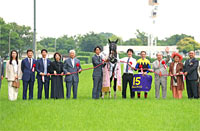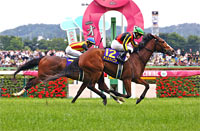2016 News
Data Analysis for the Yushun Himba (Japanese Oaks)Young fillies vie for the oaken queen’s throne The Yushun Himba (Japanese Oaks), second leg of the Triple Crown of classics for fillies and mares, is a full 800 meters longer than the first leg, the Oka Sho (Japanese 1000 Guineas). As such, aptitude for distance is an important key to success in this race. The favorite has only won twice in the last 10 years; in 2009 it was Buena Vista, and in 2010 Apapane (in a dead heat with Saint Emilion). Let’s now analyze trends in this race from results over the last 10 years, to see what kind of drama awaits us this year. First, let’s look at aggregate performances by runners over the last 10 years in terms of their position at the 4th corner in their most recent outing. The result is that horses rounding the 4th corner in “7th-10th position” and “11th position or lower” last time out have better Win ratios and Top 2 ratios than those passing it in “1st-6th position.” Although the “1st-6th” group has produced two winners, these were the 2010 dead-heat winners Apapane and Saint Emilion. But in every year other than this, the victory has gone to horses passing the 4th corner “in 7th position or lower” last time out. [Table 1] [Table 1] Performance by position at the 4th corner last time out (last 10 years)
*Includes a dead heat for 1st place in 2010. Key point: number of wins in the last 3 races Turning next to performances over the last 10 years in terms of the number of wins in the last three races, we find that each of the 11 winners had experienced at least one win during that time. Success ratios also tend to be better for runners experiencing more wins recently, with a sizeable disparity between those coming to this race with “2 or more wins” and those with “no more than 1 win.” This year, too, we should be on the lookout for horses with more victories in recent outings. [Table 2] [Table 2] Performance by wins in the last 3 races (last 10 years)
*Includes a dead heat for 1st place in 2010. Predominance of horses with fewer finishes of 4th or lower If we then analyze runners’ performances over the last 10 years in terms of their frequency of finishing 4th or lower in JRA races, those with “0” finishes of 4th or lower have amassed by far the best success ratios. Besides these, we should not overlook the fact that groups with fewer finishes of 4th or lower have higher Top 2 and Top 3 ratios, while no runner with “4 or more” finishes of 4th or lower has won this race in that time. So we should also check how often this year’s contenders have finished 4th or lower in JRA races. [Table 3] [Table 3] Performance by finishes of 4th or lower in JRA races (last 10 years)
*Includes a dead heat for 1st place in 2010. Check the record in graded races this year Now let’s look at performances over the last 10 years in terms of the runners’ highest finish in turf 1,400-1,800m graded races since the turn of the year. Here, 20 of the 30 Top 3 finishers had experienced a Top 2 place in such races, and horses with finishes of “1st” and “2nd” have also marked high success ratios. The only runners with a highest finish of 3rd or lower to have finished in the Top 2 in this race are those with finishes of “3rd” or “4th,” while those with finishes of only “5th or lower” have struggled. This year, too, we should not underestimate runners coming with a track record of Top 2 finishes in turf 1,400-1,800m graded races since the start of the year. [Table 4] [Table 4] Performance by highest finish in turf 1,400-1,800m graded races since the start of the year (last 10 years)
*Includes a dead heat for 1st place in 2010. Seek out the winner! Leading candidates among the Top 5 favorites last time out [Table 5] Performance by favoritism to win the previous race (last 8 years)
*Includes a dead heat for 1st place in 2010. (Michio Kawano) |

|



















